Galaxy note 8 comparison. Memory, RAM, chipset and performance. Design and arrangement of elements
This year Samsung company in terms of design, she radically changed hers. And many liked this state of affairs. The new Korean flagships flaunt a futuristic appearance, an elongated “limitless” display and mega-powerful technical filling. These products were rightfully considered the most technologically advanced devices on the market, but that was until the long-awaited was introduced. This is a real “monster” created for advanced users. He has absorbed all the most advanced things. However, after its announcement, the question arises about the feasibility of purchasing it, because the eighth “Laptop” is very expensive. Although it has advantages over, they are not very significant. Let's compare these two flagships from Samsung to find out which is better to buy.
Equipment
In terms of the set of accessories in the box, the devices are identical - these are excellent vacuum AKG headphones, OTG adapter, adapter for microUSB connector, fast charging unit, synchronization cable and SIM compartment needle.
Appearance and dimensions of Samsung Galaxy Note 8 vs Galaxy S8+
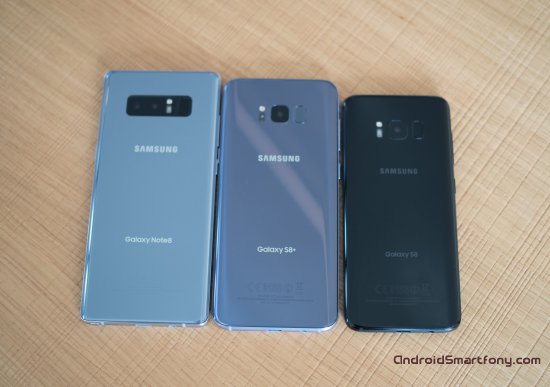
Both smartphones have a similar appearance. The materials used are the same, the edges are made of metal, and the back and front are covered with Gorilla Glass 5. However Galaxy Note 8 received a more austere, but at the same time more solid appearance. Compared to the rounded body of the Galaxy S8+, it has more sharp corners. It resembles an elongated tile. However, like its current opponent, the Note 8 fits perfectly in the hand due to the fact that the back is curved on the sides. Nothing cuts into the palm.
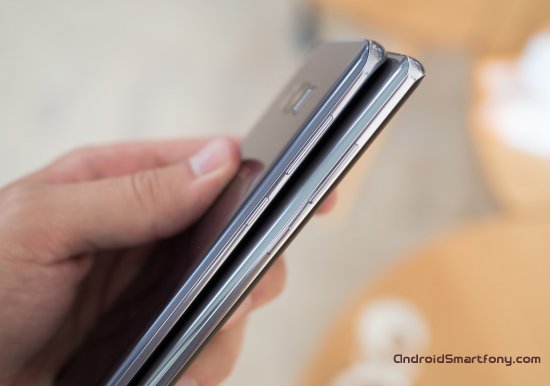
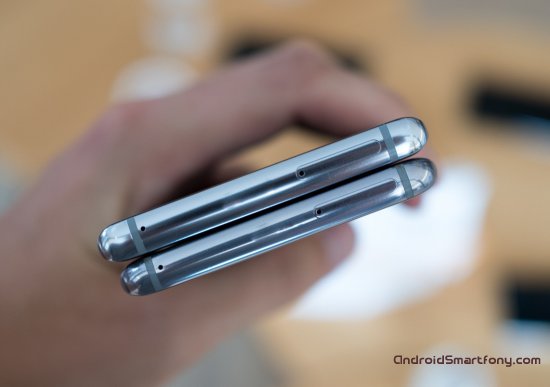
There is no difference in the location of the various components on the case. Discrepancies between devices are present only in two areas. Firstly, the Galaxy S8+ does not have a niche on the bottom, which is the “feature” of its rival. Secondly, Galaxy Note 8, for the first time in the company’s history, has a camera consisting of two lenses. The freshly baked phablet can, of course, be proud of this. However, the lack of thought in the placement of this dual photo module, combined with a fingerprint scanner, can greatly spoil the mood at the very first acquaintance with the gadget. It would have been smarter to place it vertically, but for some reason Korean engineers decided to make it horizontal. This dubious design move doesn’t look very nice, and besides, the fingerprint sensor is raised high, making it very difficult to reach. The iris detection sensor, which works a little better in the Galaxy Note 8 than in the Galaxy S8+, can save the situation. The Newbie is 0.5 inches thicker, 1.4 mm wider, 3 mm longer and 22 grams heavier. Both smartphones are equipped with a standard for protecting the case from the external environment. Interestingly, the electronic pen in the Galaxy Note 8 works even in water, because it is protected to the same standard.
Galaxy Note 8 vs Galaxy S8 Plus screen
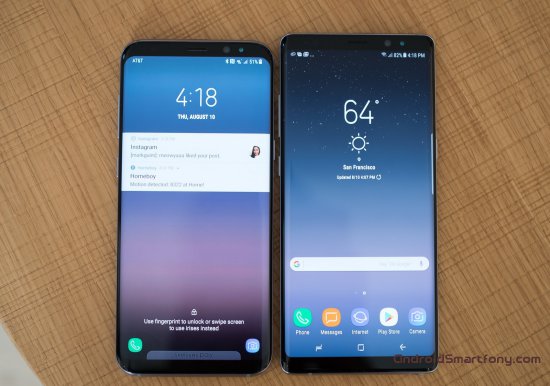
In terms of this indicator, the heroes of our comparative review have practically no differences, except for the diagonal in the Galaxy Note 8 that has increased by only 0.1 inches. During use, this difference is not particularly noticeable, since it is not that big. The matrices are absolutely identical - SuperAMOLED with a resolution of 1440 x 2960 pixels. The impressions from both screens are the same. Pixel density - 521 ppi versus 529.
Cameras Galaxy Note 8 vs S8 Plus

The most significant difference between the devices lies in the photographic parameters. The fact is that the developers finally equipped their brainchild with a dual 12 + 12 megapixel camera, and it became the Galaxy Note 8. Thanks to an additional telephoto lens with an f/2.4 aperture, the new product can not only shoot in bokeh mode, but also double the image without loss quality. The main module is wide-angle, it is equipped with f/1.7 aperture. In addition, the camera algorithms have been improved, resulting in improved frame quality. Although the opponent’s capabilities are a little more modest, they still allow you to take excellent pictures. If you do not pay attention to the lack of background blur and 2x optical zoom in the Galaxy S8+, the cameras of both devices are very similar, because the resolution is the same.
Equipment and software

The company did not change the technical component of the Galaxy Note 8. Like its current rival, it is built on the 8-core Snapdragon 835 and Exynos 8895 chipsets. The processor version depends, as before, on the sales region. The Galaxy S8+ model can be purchased with 4 or 6 GB of RAM on board, and the Notebook only has a 6 GB memory module, while the choice of flash memory is larger - 64, 128 or 256 GB. The Galaxy S8+ does not have a 256 GB drive, but few people are interested in it. As for wireless modules, the devices are absolutely equal in this regard.
There are differences in battery capacity. Surprisingly, the Galaxy Note 8 has a weaker battery by a good 200 mAh. This decision seems strange also taking into account the fact that this smartphone thicker.
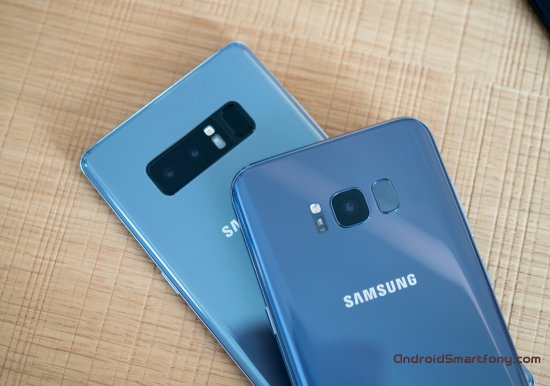
The software content in both Korean products is provided by proprietary firmware, which is based on the seventh Android versions. The interface in the Galaxy Note 8 is designed for the S-Pen stylus, so there are some differences in the OS. Also, the recently introduced device was equipped with an interesting function of adding a shortcut to the side panel, by clicking on which you can open two applications in one click. They immediately work together in split-screen mode, which is quite convenient.
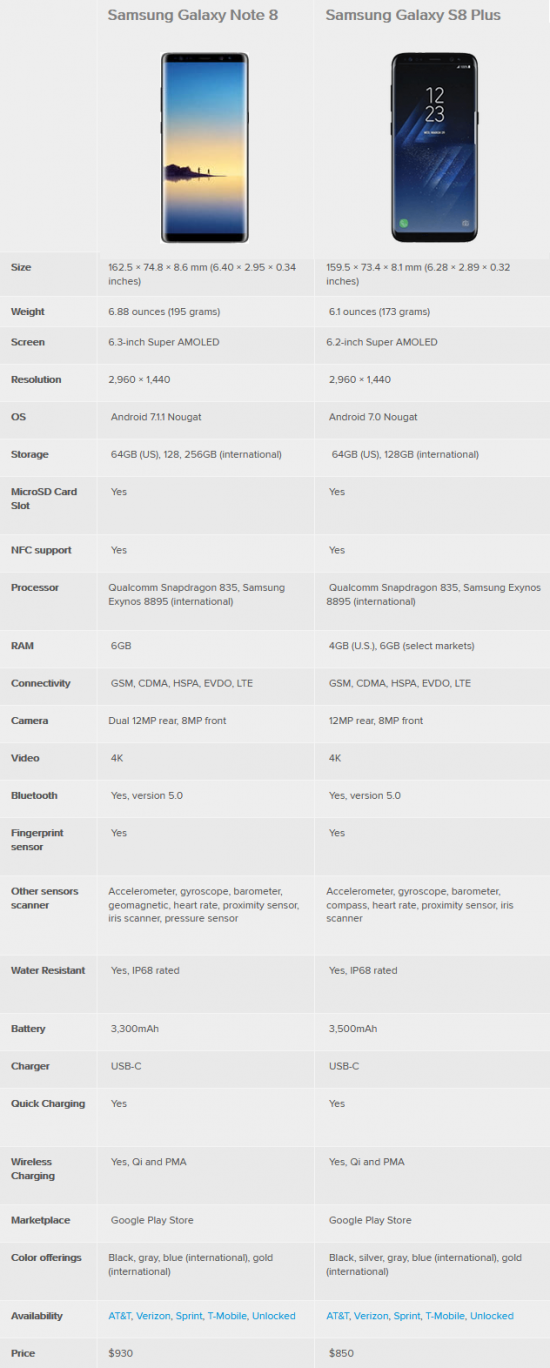
Conclusion
So, if you don’t need a dual camera and you don’t need a stylus at all to work with your smartphone, then best choice There will be a Galaxy S8+, because the Galaxy Note 8 does not surpass it in anything else. For significantly less money you get exactly the same arsenal of capabilities. There is no reason to overpay for a new product, especially since the battery in “Plus” is even better. However, users who are interested in having the most fully equipped device on their hands will definitely look towards the Galaxy Note 8, and this smartphone is designed for such people. |
 |
|
 |
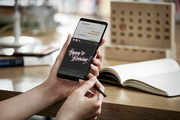 |
 |
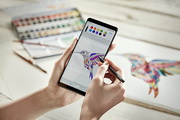 |
 |
 |
Price positioning, B2B solution, iPhone X Plus competitor
Samsung's Note line has never been massive; sales have always been tens of percent of the level of the current flagship with a larger diagonal. The reason is not only the price, but also the positioning of the device, which was aimed at three small groups - flagship lovers and geeks, as well as a business audience for whom the additional functions of the device are important, plus a small layer of those who love and know how to draw. For the last two groups, even the name itself reflected the meaning of the device: it is a notepad, but a modern, electronic notepad. But you can write with a pen, which is called the S Pen, which is initially present in a special compartment in the case and is quite convenient in everyday life.
There have never been and are no direct competitors to the Note line on the market, since no one has been able to create anything similar at the level of both software and hardware. Attempts to create similar devices were made many times, but all of them were unsuccessful. Moreover, often such devices were positioned much cheaper, but people simply ignored them - it turned out that it was important for the target audience not just to buy something with a certain stylus, it was important for them to get a variety of software, new features, and they were willing to pay for it.
The success of the Note line was unexpected; from a niche device not for everyone, the model instantly became a mass device, the company’s second flagship within a year. Before Note 5, Samsung tried to provide the very best technology in this device, but then there was a reassessment of values. Thus, Note 5 turned out to be quite unsuccessful in sales, as they refused to support memory cards, just like other devices of that generation from Samsung. For Note line consumers and Note 4 owners, this was a big blow (and Note 2 at that time as well). The index “six” was missed, and with Note 7 there was a story with fires, which could have put an end to the entire product line, but this did not happen. But again the positioning has changed a little, now Samsung is not trying to please geeks, the production cycle has changed so that the Note does not receive the latest developments in the field of chipsets and memory, it becomes an analogue of an already existing flagship. The logic of this decision is clear, the best should go to the S9, which is already in development, while the Note will actively highlight and promote its strengths.
The business audience for this device has always been strong, but today the promotion of the Note line is reaching a completely new level, as an accessory such as DeX has appeared, which turns the phone into a full-fledged computer or its like.
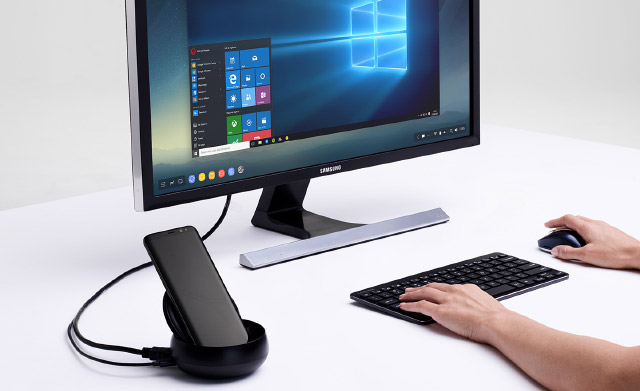
In the B2B segment, the company’s plans for Note 8 are very large; this device will be offered to corporations as part of existing and new projects, and there are no analogues to such a solution at the moment, which allows us to talk about a fairly successful implementation. I am sure that throughout the year we will hear about certain companies purchasing Note 8 for their employees. DeX will gradually begin to penetrate the corporate market, perhaps this will become a trend, they want to make something difficult here.
Market-wise, the Note 8 only has one or two competitors, and that's the iPhone 7 Plus and its sequel. The reason is that many will compare the two most expensive solutions from direct competitors, ordinary consumers that's exactly what they'll do. At the same time, they also have a seemingly similar camera solution (optical zoom), which gives even more similarity in the eyes of buyers. In principle, in this price segment there are de facto only two names - Apple and Samsung, sales of all other players amount to at most 5%, and the number of these players is more than a dozen. But consumers do not choose them, but focus only on familiar names.
Initial sales plans for Note 8 were modest, up to 10% of S8+ sales. A few months before the start of sales, after partners began to place orders, the plan was revised and increased threefold. Cause? The market believed in the product and believes that it will be in demand. Let's try to evaluate why this is so.
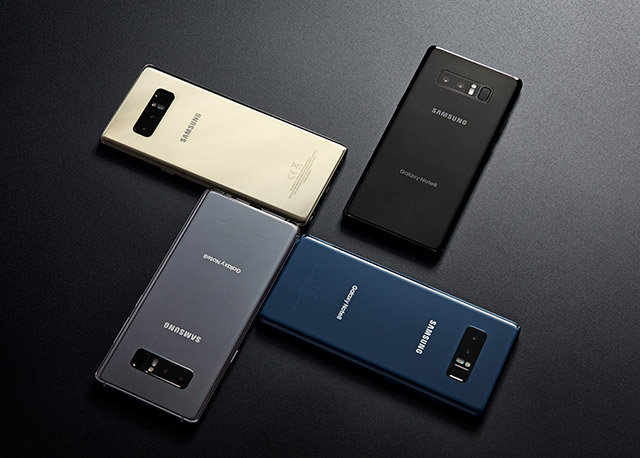
Design, dimensions, control elements
The first thing that comes to mind when you look at the Note 8 is that this is some version of the S8+, the devices are very similar. Place the S8+ next to it, and then you will notice a difference in a number of ways, but you will have to look closely. The designers tried to achieve maximum resemblance to a notepad, hence the slightly chopped edges, which in real life do not add any problems to the use of the device.


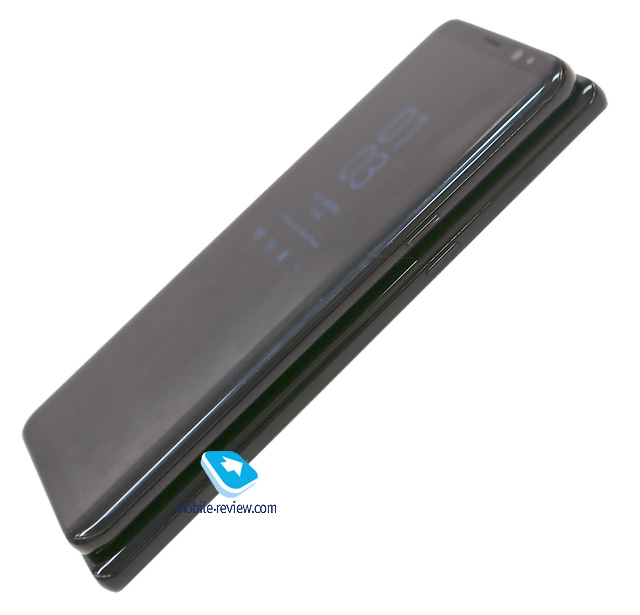

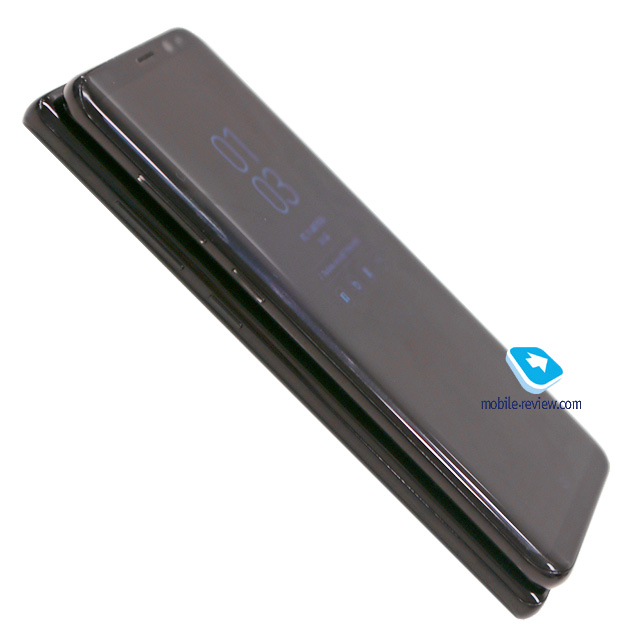
Compared to Galaxy S8+
And this model differs from previous Notes in its shape.

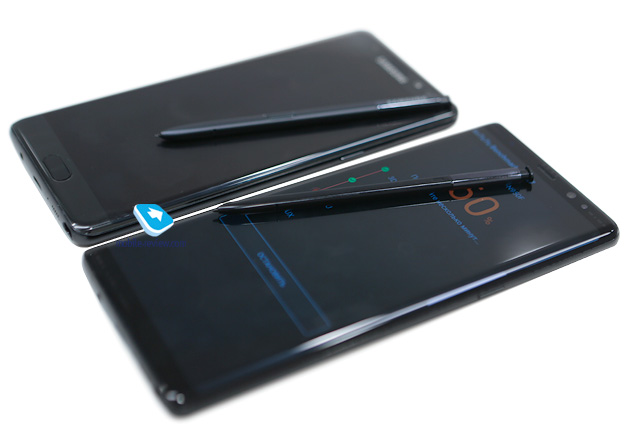

The sizes of the devices are comparable, they do not differ very much, a couple of millimeters does not allow us to say that the Note 8 is huge - it fits perfectly in the hand, is invisible in your pocket, and is convenient to use with one hand. So, the dimensions of Note 8 are 162.5 x 74.6 x 8.5 mm, in S8+ it is 159.5 x 73.4 x 8.1 mm. The exception is the fingerprint sensor, which is still located on the back surface as in the S8+, but it has been moved so that the camera window cannot be accidentally stained. Samsung was never able to make progress with an under-glass sensor; moreover, it may not be in the S9 either, since serious engineering difficulties arose, the same with Apple. It is curious that both manufacturers are trying to buy out the technology of a third company through its purchase and are struggling with their proposals, hoping that they will be the first to make such a decision.
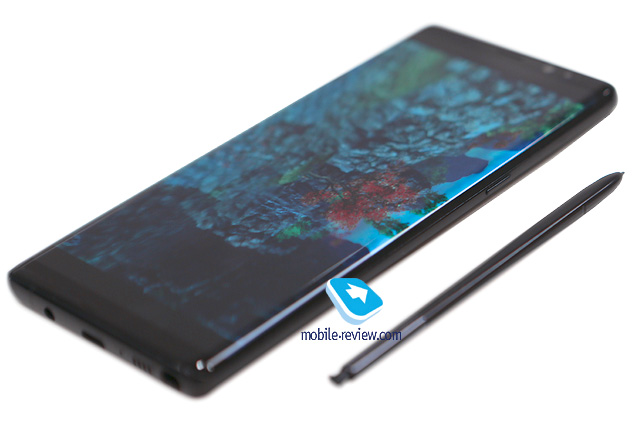

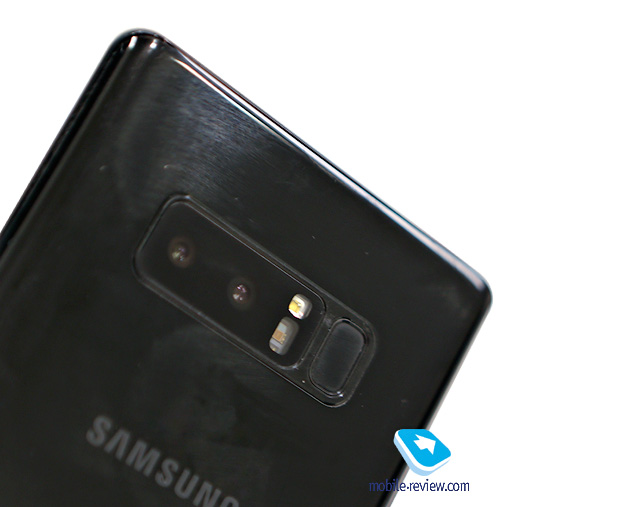
The curve of the case is felt exactly the same; Corning Gorilla Glass 5 is used (a special version without markings, it was created for this device). The IP68 protection has not gone away, the device can easily live under water. The internal layout of the device has been slightly redesigned to improve protection after accidental drops, so that no cracks occur and water cannot damage anything inside.
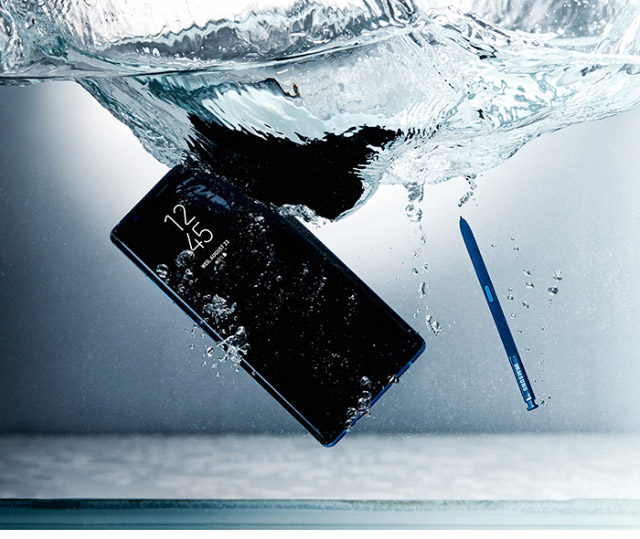
The layout of the buttons and connectors is almost exactly the same as on the G8; there is a separate Bixby key, as well as a SIM card slot combined with a memory card. Nowhere in the world will there be a device with a separate slot for two SIM cards and a memory card, only combined ones.
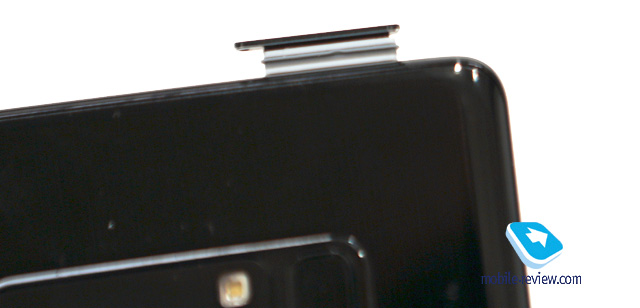

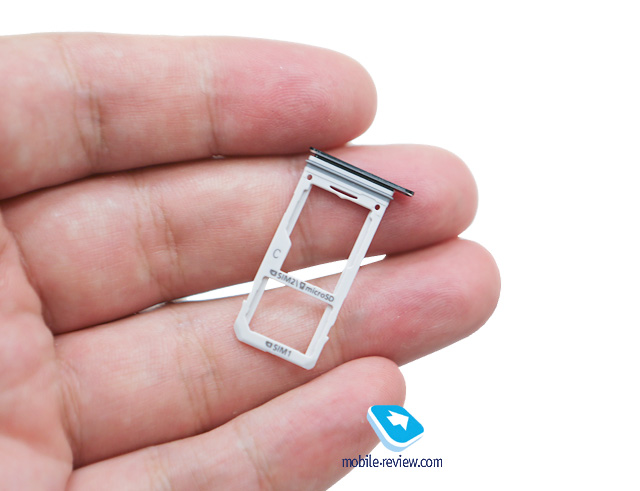
In terms of materials, there are no discoveries, it is exactly the same 7000 aluminum alloy, the coating is the same as in S8/S8+, the structure of the varnish has changed, it is more scratch-resistant.
You won't be able to insert the S-Pen the wrong way around; foolproof protection was added by default. As well as all the usual options for the stylus, you can write by hand on the locked screen, add reminders (expanded functionality) and mark individual events. The S-Pen itself has not undergone major changes compared to the Note 7; it feels exactly the same pen, comfortable and practical.
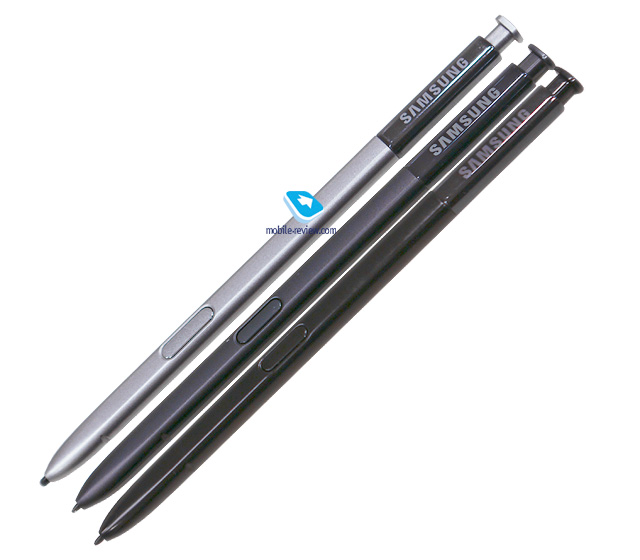
The iris scanner has changed, it now has an updated version of hardware and software, it works a little faster in the dark, and about the same in daylight. We have added a new learning algorithm; the more often and under different conditions you use the scanner, the better and faster it recognizes your eyes. The face scanner has become a little more complex, but it is still less secure than the iris scanner.
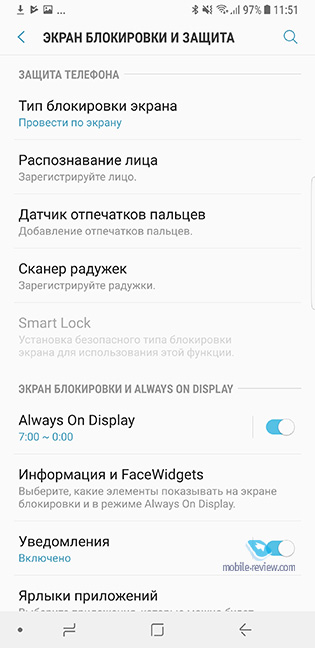
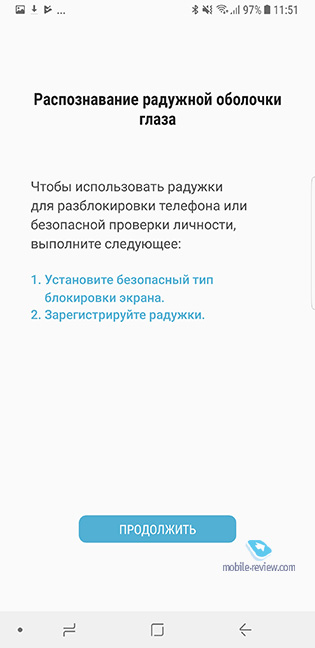

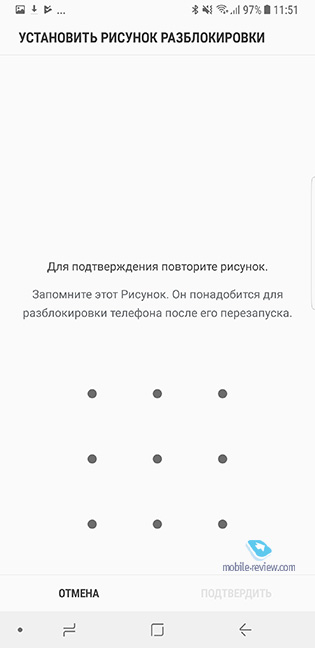
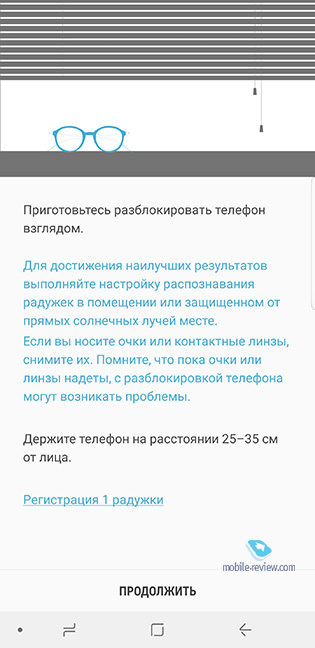

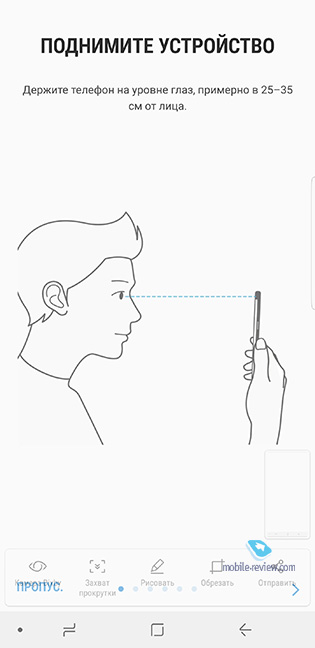

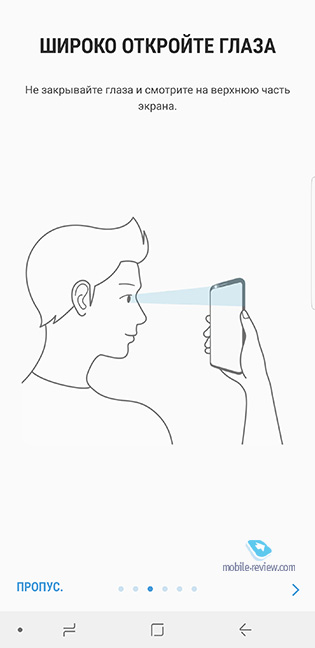

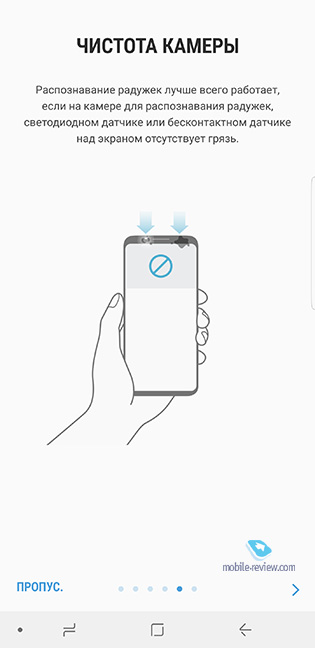

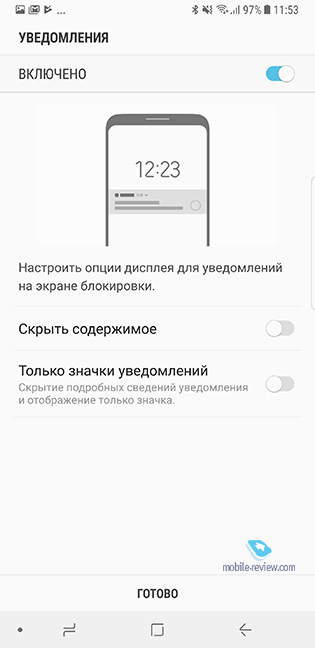

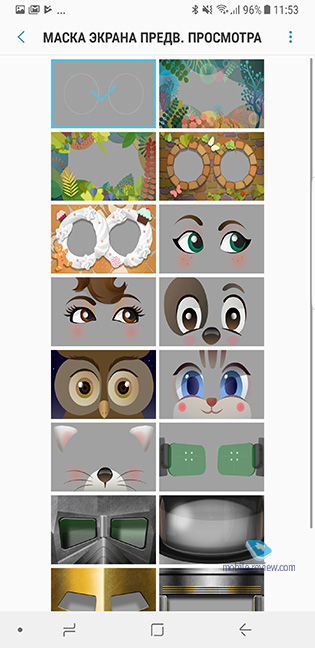
Display
The screen diagonal is 6.3 inches, but here the difference with the S8+ is practically not felt; the added 0.1 inches had a minimal effect on the height of the device, and not on its width. And if the S8+ was a huge TV, then this effect is only enhanced here. Shovel or not, this question will definitely be asked constantly, but when you watch a movie on this screen once, this question will disappear by itself. Geometry is the same 2 to 1, resolution is 2K, or, more precisely, QuadHD+. The screen type is SuperAMOLED, but, as usual, this is the latest generation, in which many characteristics invisible at first glance have been improved in small ways:
- better color gamut;
- new algorithm for assessing external lighting, RGB light sensor;
- new DSP for on-screen image processing, integrated with Bixby;
- new color profiles for developers and users.
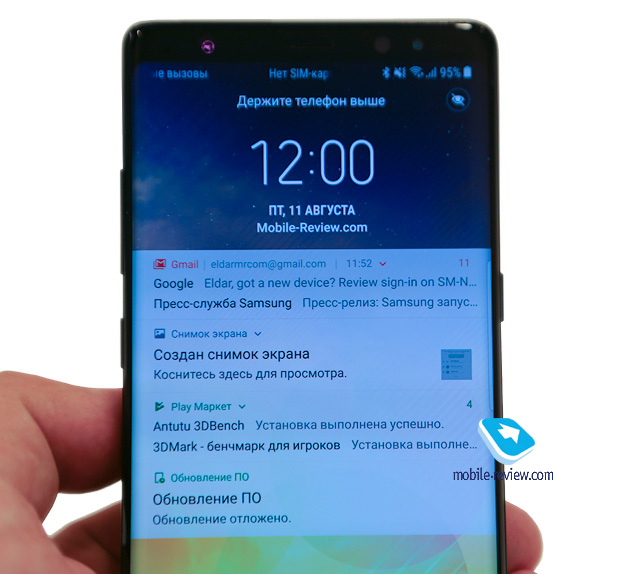
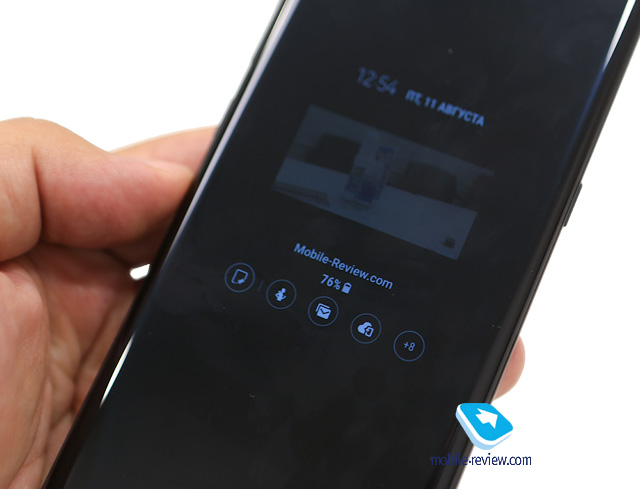
IN real life It’s almost impossible to see a strong difference between the screen of the S8+ and Note 8; the screens simply behave differently in different lighting conditions; in order to appreciate this difference, you need to use them. Therefore, after the presentation, many will say that the screens are equivalent, and, perhaps, for typical situations this is true. But for difficult situations, the Note 8 will win, as usual, the latest flagship has the latest screen in terms of technology.

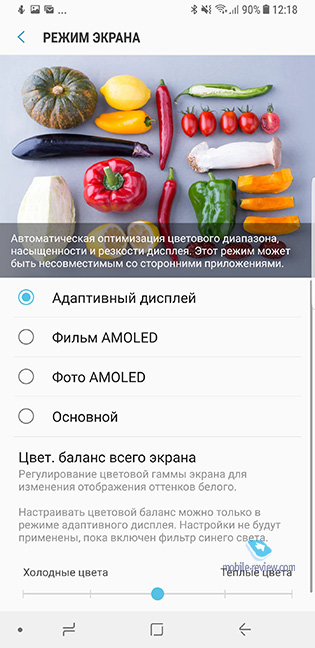
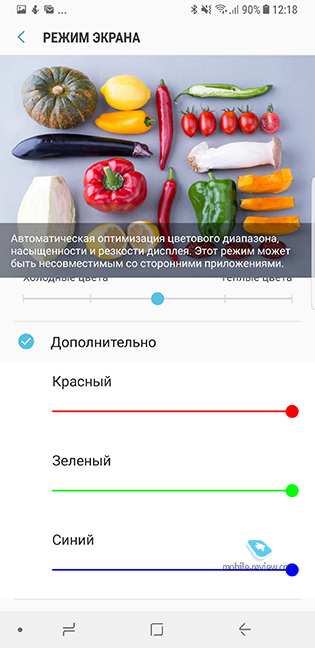

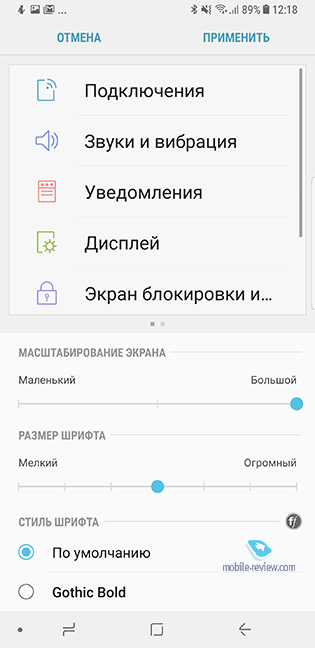



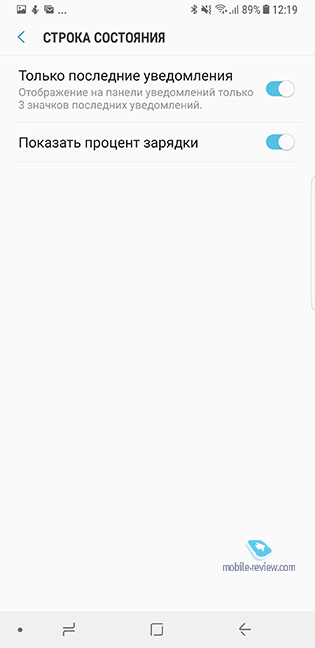
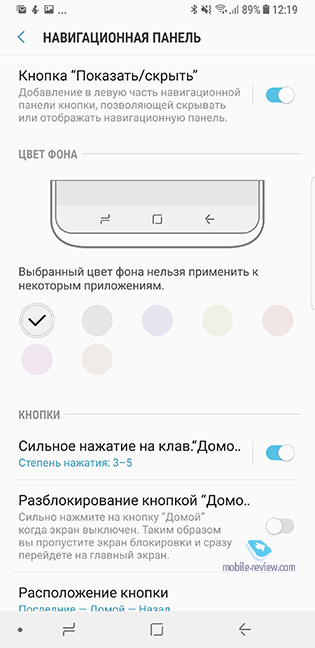
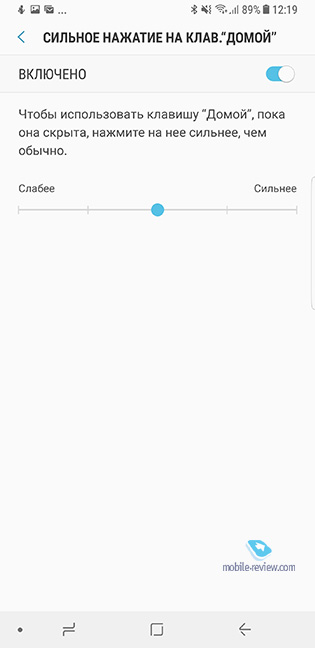
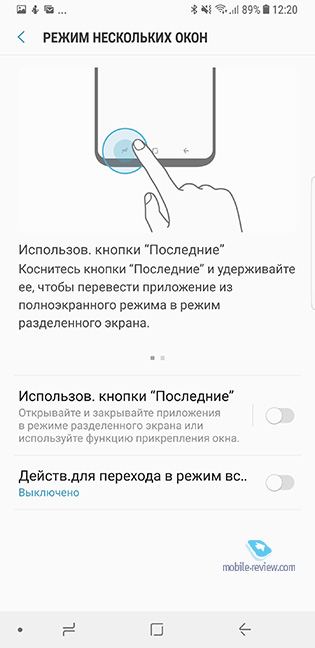

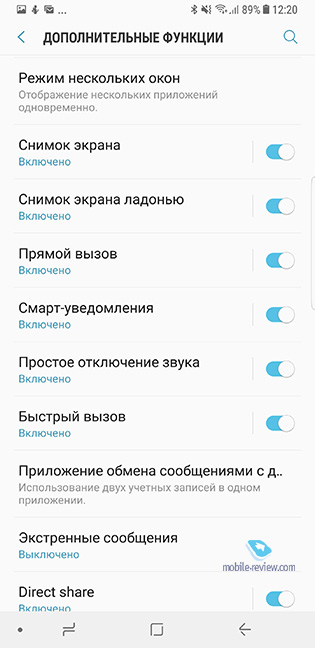

Memory, RAM, chipset and performance
I don't understand why China always gets versions of devices with more memory. So, in the USA and Europe the model will appear with a RAM capacity of 6 GB; a device with 8 GB of RAM will be released for the Chinese market a little later. Built-in memory 64 GB, plus memory cards up to 2 TB. A version with 128 GB of internal memory will appear later, availability in Russia is unknown.
A model with Snapdragon 835 (10 nm) is coming out for the USA, but for the rest of the world, including Russia, it will be Exynos 8895 (also 10 nm), which is well known to us from the S8/S8+.
The performance of the chipset is typical for current models, but look at the results for yourself.
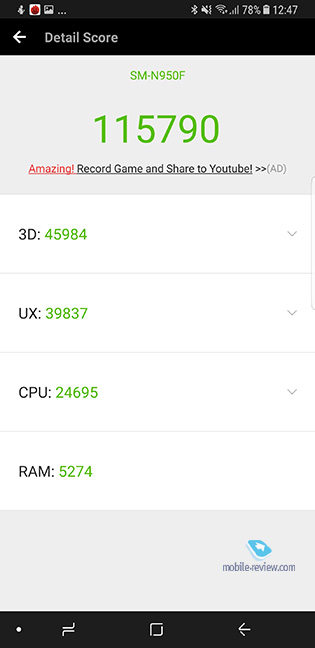
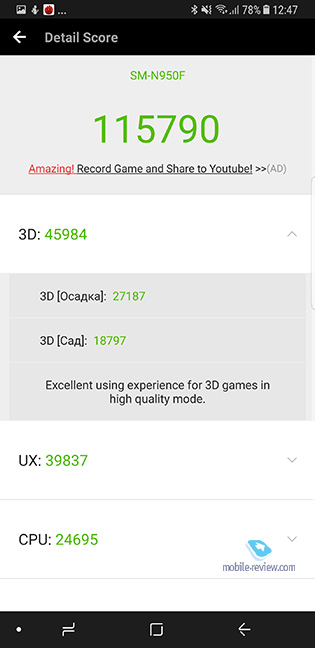

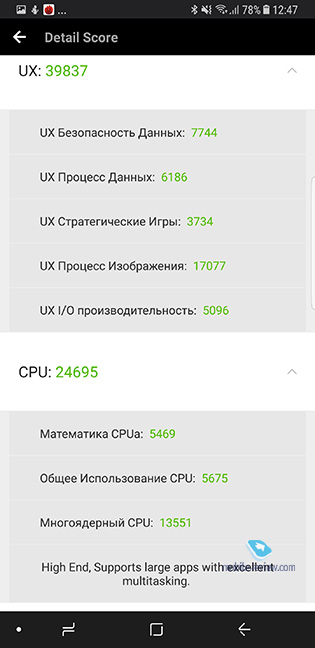
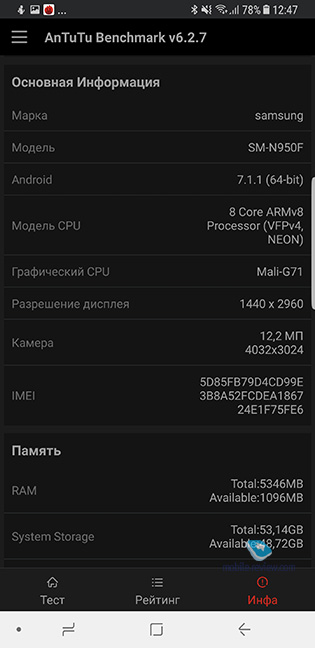
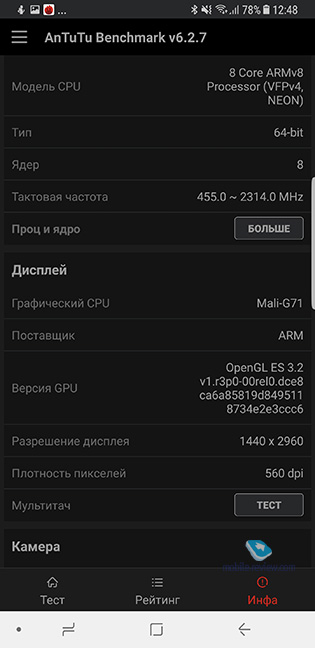
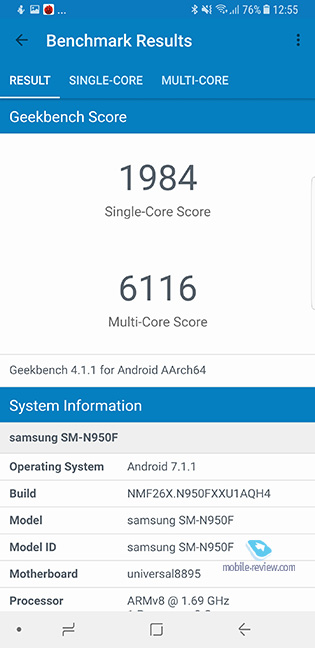

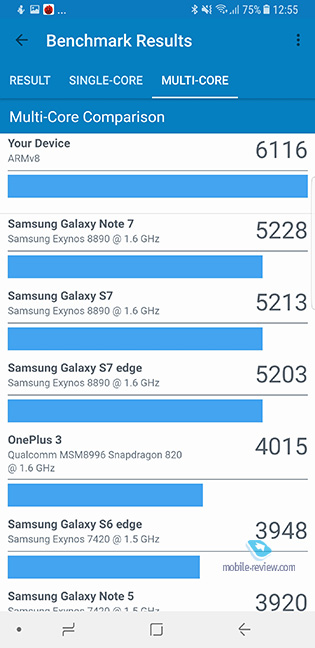

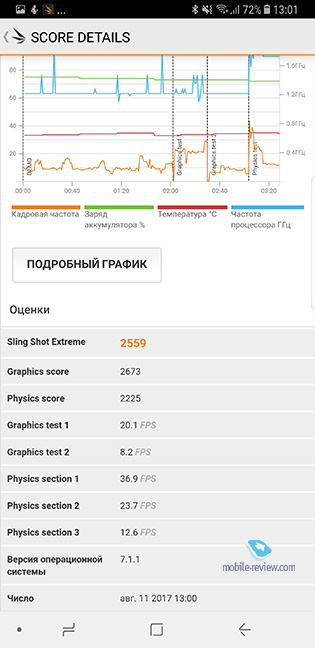

Battery
The Li-Ion battery is 3300 mAh, which is slightly smaller than the battery installed in the S8+. However, both devices provide comparable operating time under the same scenarios. For those who use the device to its fullest, this is up to one day of work, or with all sorts of settings and a skillful approach, two to three days of work and 7-8 hours of screen work.
On this moment The S8+ is the longest-lived flagship, especially with this screen size. In Note 8 we see the same thing. As usual, there is wireless charger, built into the body, fast charging and extreme energy saving mode, everything remains unchanged.
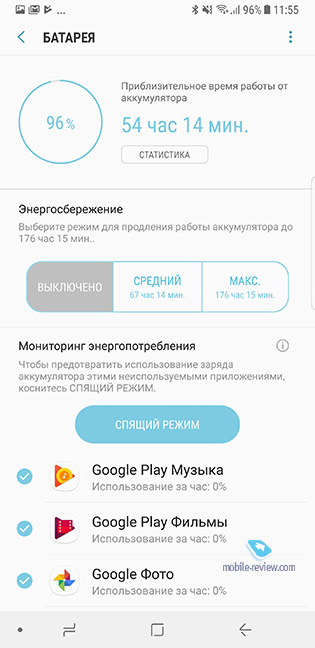
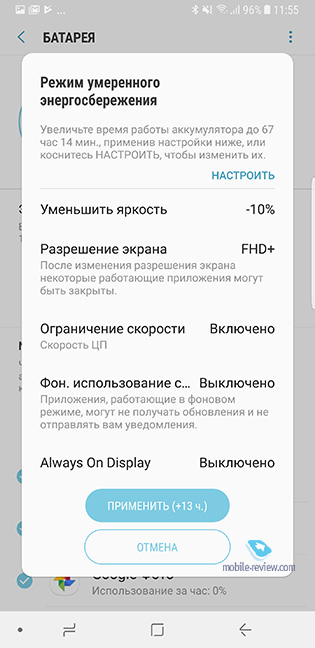
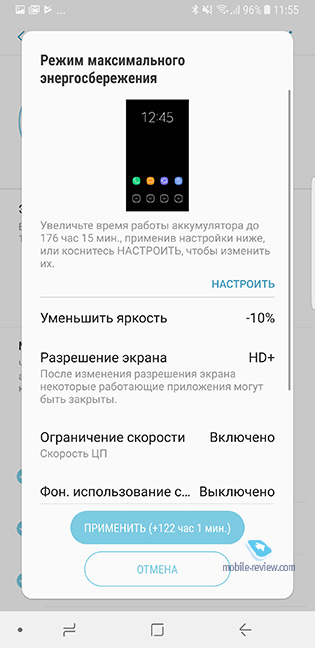
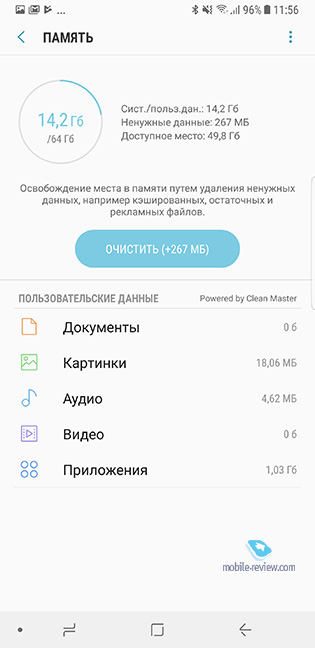
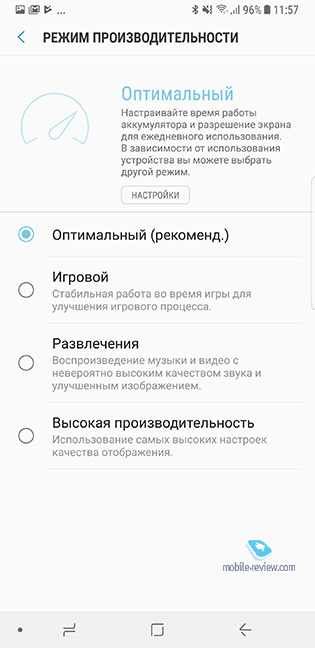
Camera
In Note 8, the main camera is made dual for the first time; formally, the main module is a 12-megapixel sensor, which we see in the S8/S8+, but the camera logic and algorithms have been completely redesigned. IN latest update S8/S8+, some of these algorithms have already been used, while maintaining the clarity of the pictures, they have become a little lighter and brighter, they don’t cut the eye with ringing clarity, they’re a little more natural. Although these differences need to be looked for, and none of the normal people will do this.
The presence of a second sensor allows for a whole range of new shooting modes, and here we see a clear answer to the iPhone 7 Plus and its two modules. Thus, selective focusing has appeared on the image - blurring the background, and the degree of this blur is regulated, post-processing is always available. Among the improvements to the camera, it should be noted greater clarity and less noise when shooting at night (this is true strong point Samsung, but it's even better), updated HDR mode (HDR+ or something similar). If other companies are trying to improve night photography by improving optics, then here they stitched two simultaneously taken images from two cameras (this is where the fact that the second module is not monochrome, but regular) comes in handy. In fact, one camera is wide-angle and the other is zoom.
It is important to know that the camera module differs in optics from the S8/S8+; a regular photo has a large zoom. There is a x2 icon in the menu, that is, this is an optical zoom, compared to the S8/S8+, the increase will be x3, which is where it came from in all the descriptions. But on the device itself the magnification is x2, which is enough for the eyes. However, see for yourself. Since the zoom is optical, there is no loss in image quality.

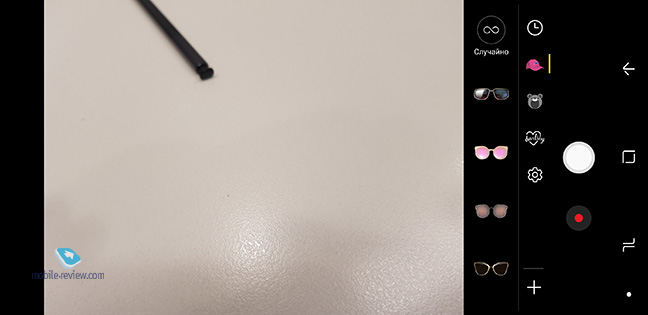

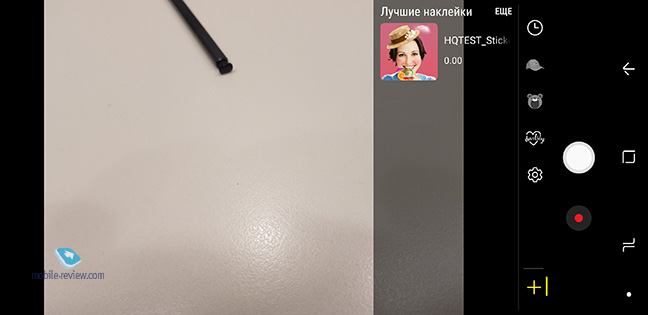


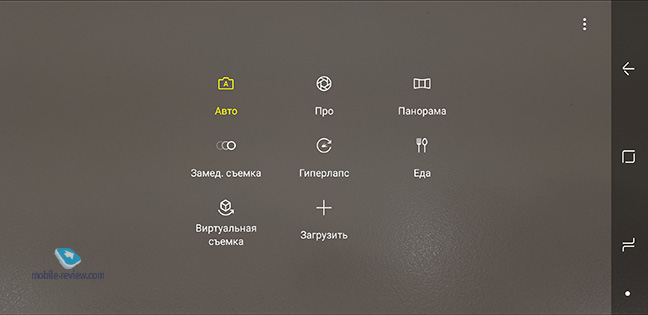
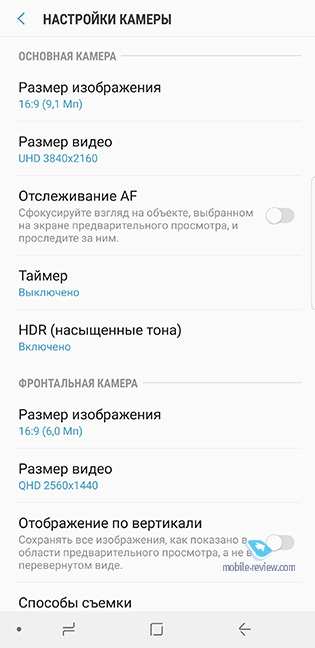
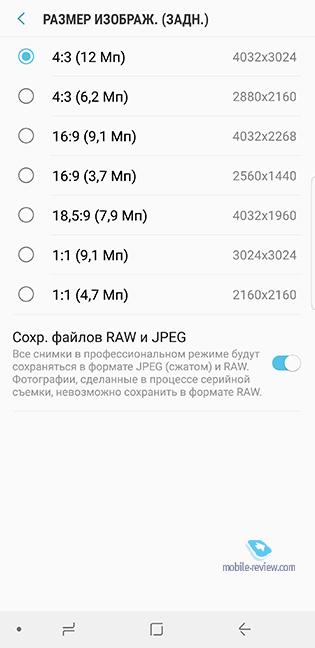

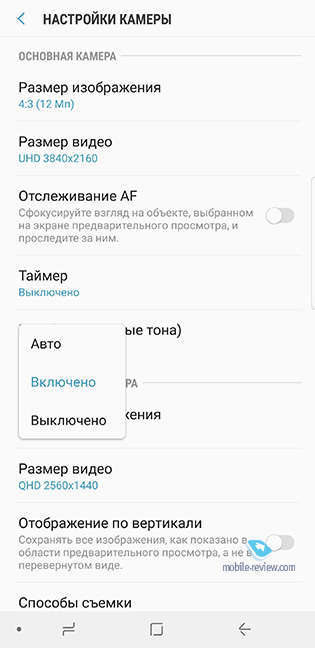
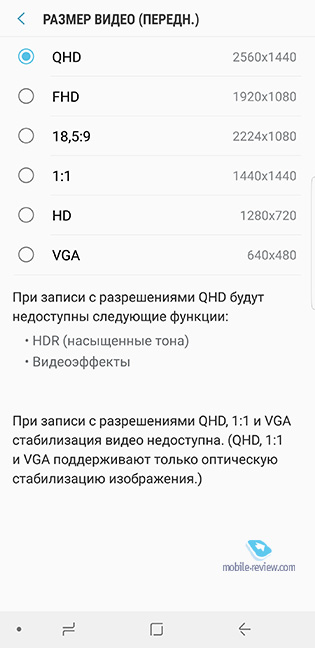


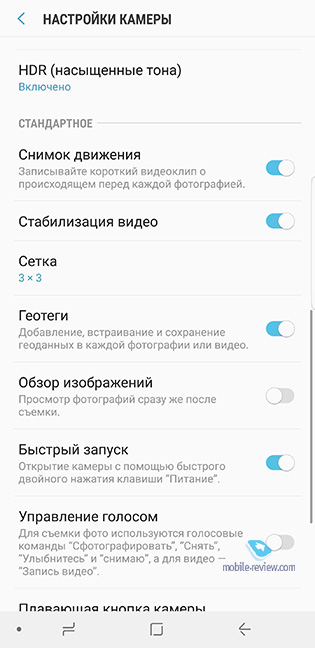
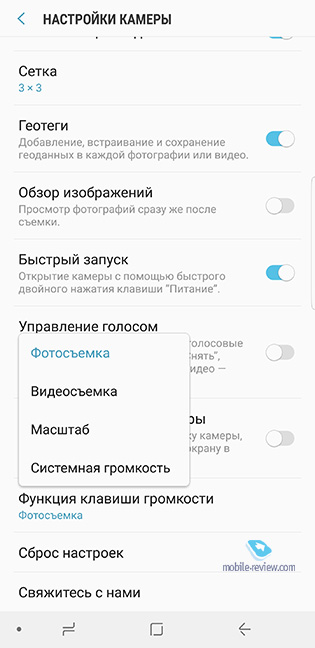
Examples of photos (tele-module)



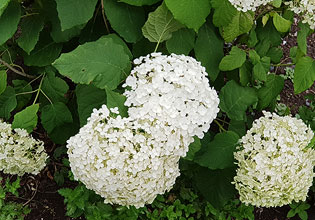




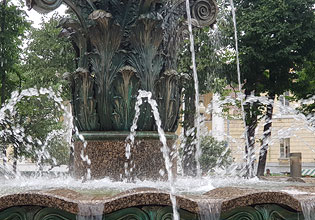


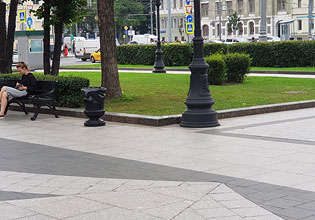


front-camera


And this is what blur looks like in pictures.
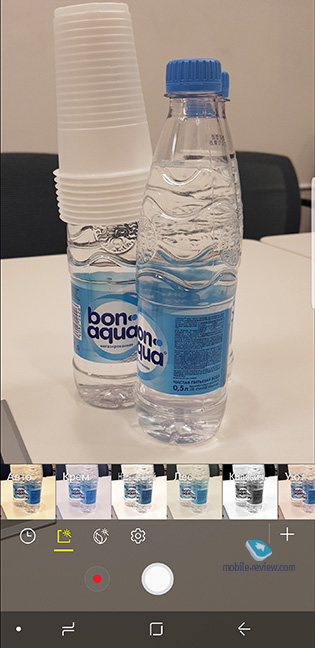
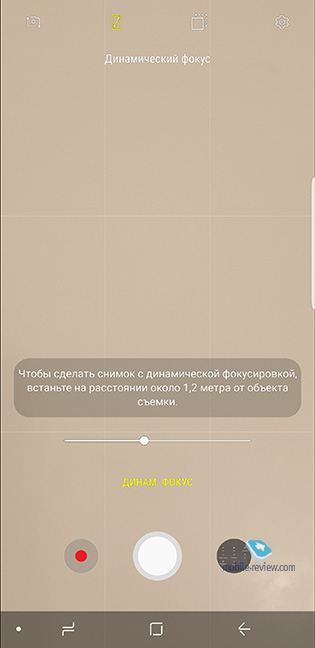
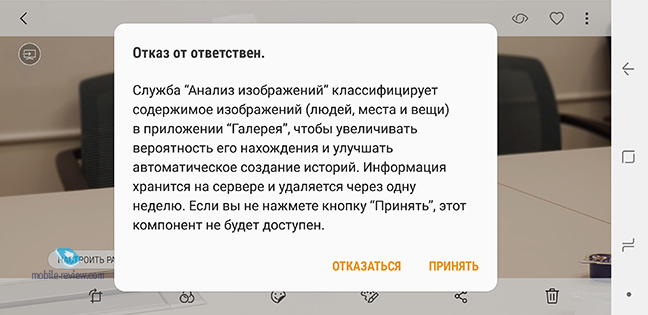
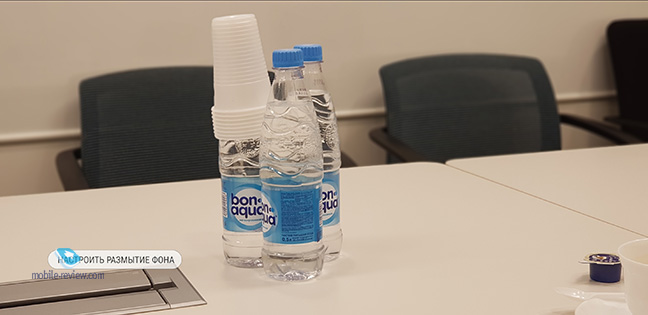


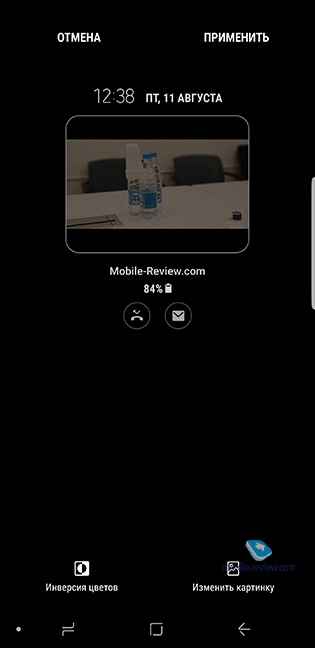
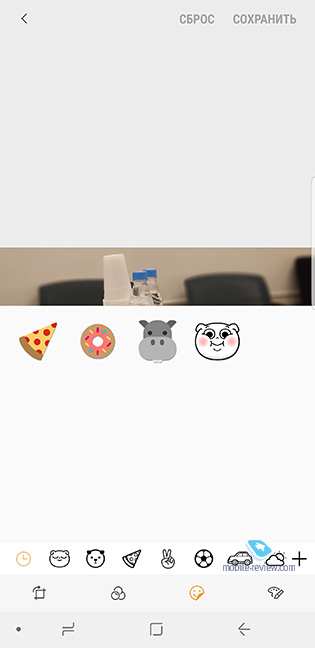


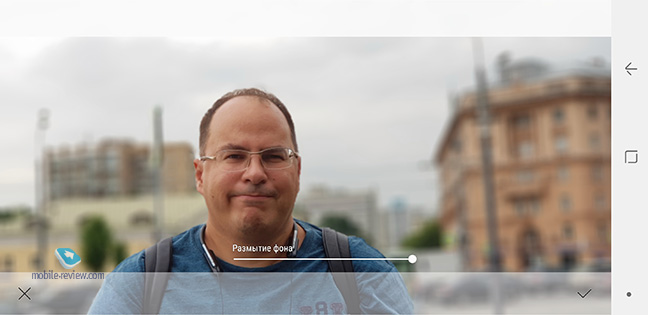
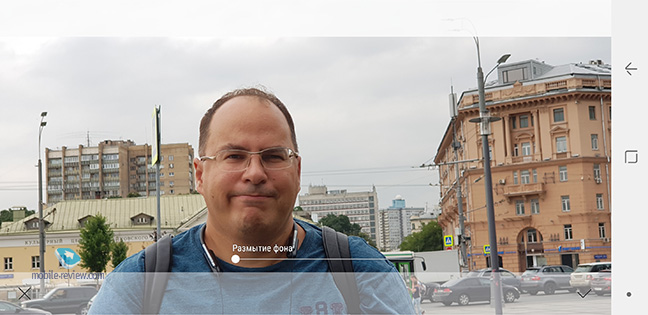


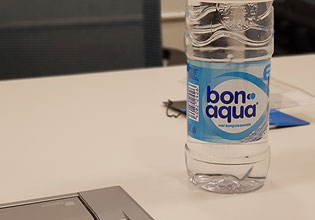
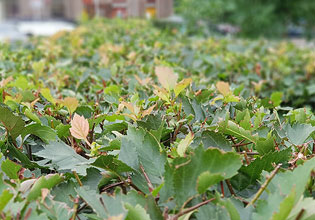



In general, we can say that the camera has not made a resounding leap forward, but evolutionarily it has been greatly improved compared to the S8/S8+ and provides new opportunities for those who are interested in photography (portrait photography, better macro). I don’t want to get into a debate about which device has a better camera; in my opinion, these are always the latest flagships from Samsung, as they provide space for creativity and the opportunity to take pictures even in difficult conditions. The Note 8 camera is very decent in different modes, including full version The review will contain more different photos a little later, but not from the prototype, but from a commercial sample.
For now, you can see a comparison of shots with the S8+.
| Galaxy Note 8 | Galaxy S8+ |
 |
 |
 |
 |
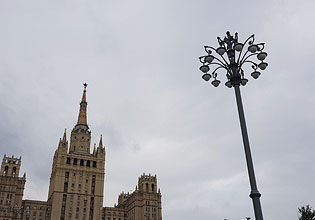 |
 |
 |
 |
 |
 |
 |
|
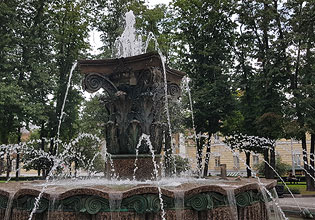 |
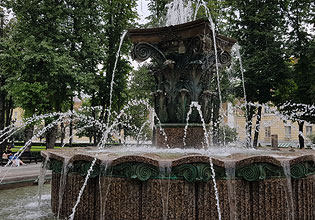 |
How the S Pen works and what it can do
Let me start with the fact that most people consider the S Pen to be an additional and practically unnecessary thing; they very rarely use the stylus built into the case. On the other hand, there is a creative minority that is accustomed to pens, loves to draw, and they, on the contrary, do not let go of the S Pen, create beautiful drawings, sketches, in a word, constantly use the stylus. These two categories of people will never be able to understand each other, they have too much different tasks and needs. Unfortunately, I never learned to draw something other than stick-stick-circle, and ultimately a little man, so I consider myself to be among the majority without any special artistic talents. For people like me, there are coloring pages, you can paint over the templates, it looks very beautiful.

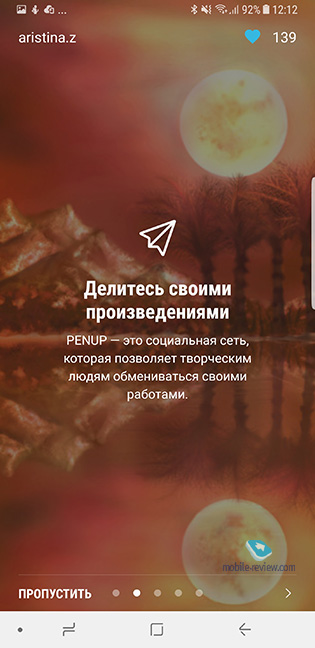




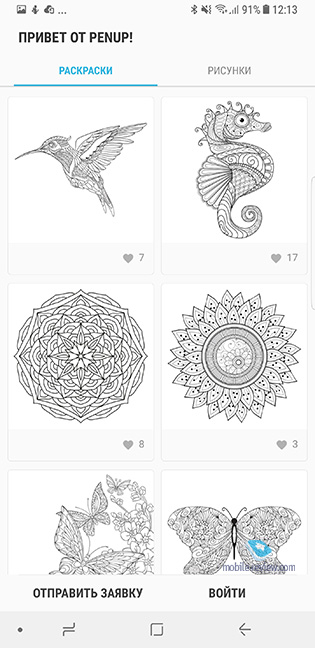
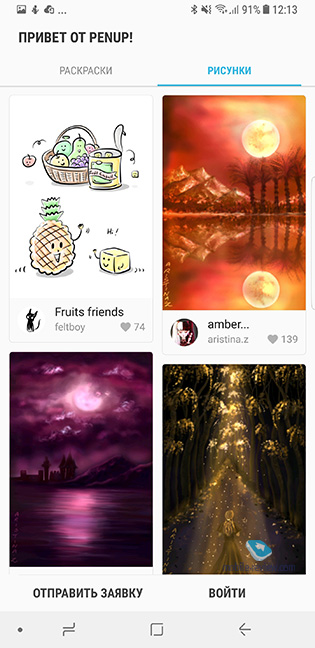

For me, the S Pen is the ability to leave a quick note, write on the screen, without even unlocking the phone. This is very useful in meetings when you need to remember something and don't need to write it down in a notebook. Short notes on the run, which are also synchronized with the cloud. Now you can record not only one screen, it can be endless, you scroll through it vertically, plus there is the ability to leave it on the waiting screen, pin it in one place.
But perhaps the most important thing is the ability to take a screenshot of a page that does not fit on the entire screen. The function appeared in Note 5; it has come in handy more than once for me to show certain things, to instantly send them as one file, rather than torn pages.
Another important point is the ability to take a screenshot anywhere on the screen and immediately draw something on it, cut out a piece. It's also interesting for those who work with graphics and the like.
From the useful side, I’ll tell you about the ability to recognize text in pictures, that is, you save everything that you photographed or took a screenshot of, not just as graphics, you can remove the text from there. This is an indispensable tool in my work.
A new feature is the translation of individual words; in this mode, you set the direction of translation and you can spy on any words that will be immediately shown. The Google engine is used, the function is pleasant for those who study or constantly correspond in different languages, not always having a dictionary at hand.
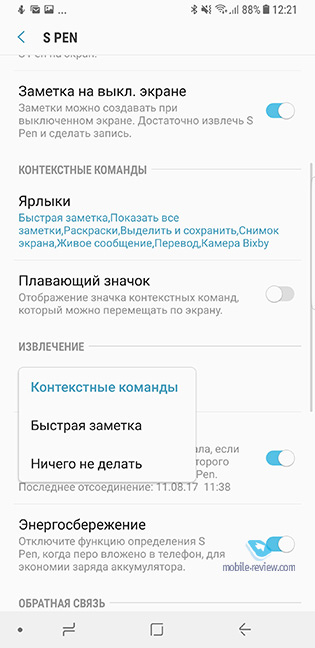

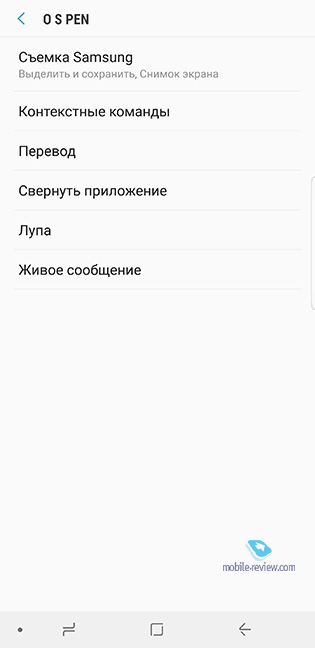
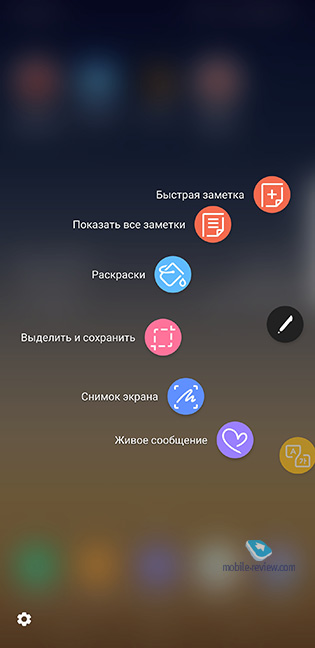

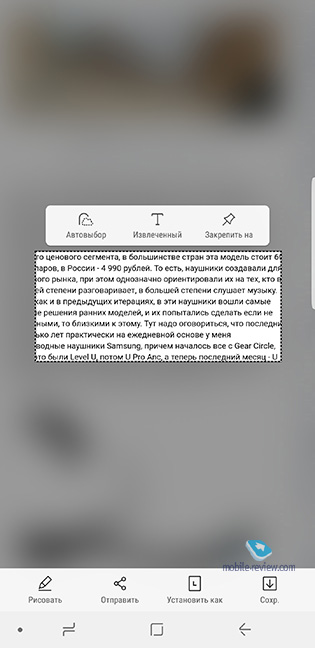
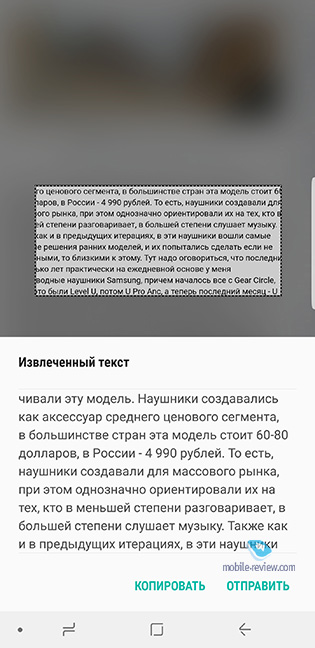
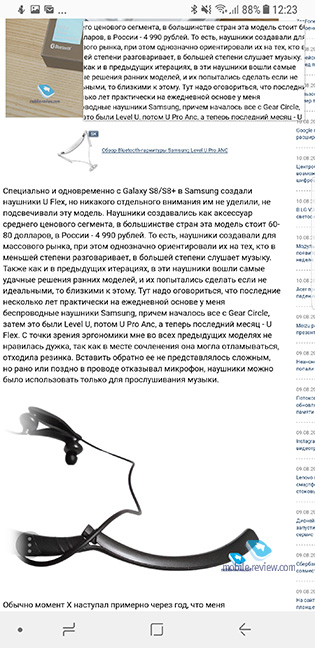




The fact that the S Pen works underwater, in my opinion, is nonsense. It is unlikely that scuba divers will use a phone while diving, and even at a depth of two meters it will simply leak. But the fact that you can write in the rain is a real application scenario that is easy to imagine.
The pen, as before, takes into account 2048 degrees of pressure. The S Note app has a drawing mode where you can mix colors, something that wasn't available before.
I can’t say that I use the S Pen very actively, sometimes it happens that I don’t take it out for several days, sometimes a couple of times a day I draw something on screenshots, cut out pictures. But I can say for sure that it helps me quickly complete routine tasks that I encounter from time to time. There is simply nothing like this in other phones. Handwritten text recognition has become noticeably better, but, in my opinion, this is not as convenient as simply typing text on the keyboard, although perhaps someone thinks the opposite. I am sure that there are fewer and fewer people writing every year. And therefore, the S Pen is not so much for writing as for performing tasks in which the stylus is difficult to replace with a finger.
R'иджет от SocialMart
Impression
I did not have any high expectations from this device, since I have known it for a long time. The main changes that appeared compared to the S8+ are the presence of the S Pen, a slightly different body shape, which is not fundamental, as well as a slightly larger screen. The most important thing is the new camera module, which gives noticeably more space for creativity, and I like it. As well as the fact that the technique allows you to pull out pictures that otherwise would not have turned out.
In Russia, sales of Note 8 will begin in the second half of September at a price of 69,990 rubles; as usual, pre-orders will be open. As far as I know, those who pay for the device before the start of sales will receive it first, plus they will give a DeX station as a gift (it costs 9,990 rubles separately, a valuable gift). The price, as always for flagships, causes heated discussions and rejection by part of the audience, but sales prove that such devices sell well, and this will happen now. For those looking for a model that will last for several years, this is a very good choice that is worth considering carefully. It’s interesting that more programs are being adapted for the DeX station, for example, a version of World of Tanks is appearing that will work with a keyboard and mouse, and other games and programs are on the way.
Let's see what they show in the new one iPhone Plus, but I don’t expect anything unusual, the stylus apparently won’t appear there, which means that, as before, these are completely different categories of products, a regular phablet versus a unique device.
My emotions from Note 8 are simple - there is no delight, this is a well-known device, as if I bought comfortable shoes in which my feet immediately feel good. Everything is in its place, everything is correctly located. And a little more than that, I really missed the S Pen, and the fact that it’s back is good. The camera is simply even more pleasing than before. Pleases with the possibilities. The review will be in September, so I’ll go over all the details in detail and compare the cameras with the iPhone 7 Plus. Stay in touch.
When the first Galaxy Note came out, many people laughed at the device and its large size. Undoubtedly, few expected Samsung's enormous smartphone to be a commercial success, let alone an entire series that would still be around six years later. now we have Samsung Galaxy Note 8: This is a big, powerful and capable smartphone that attracts geeks.
But at the same time, the Samsung Galaxy Note 8 is very similar to the Galaxy S8+, which appeared on the market a few months earlier. Next we will show how these two animals differ from each other.
Galaxy S8+ – huge smartphone, but the Galaxy Note 8 is no less. In fact, it's slightly wider and taller, as it houses a 6.3-inch display (versus the S8+'s 6.2-inch). With a slightly larger screen and less rounded edges, the Galaxy Note 8 feels a little chunkier. Thanks to the so-called infinity display, which occupies almost the entire front panel, both models have a narrower shape. Therefore, despite the size of their screens, they are not difficult to hold and use. It should be noted that the Galaxy Note 8 is noticeably heavier.
In any case, both smartphones are very similar in their designs, with the impeccable superiority achieved through the use of curved glass and metal. If it weren't for the different color options, you'd have a harder time telling them apart. Their displays look equally bright and colorful, with an always-on display feature and an identical set of on-screen navigation buttons. And yes, both are protected from dust and moisture according to the IP68 certificate.
Software and Interface: Using the S Pen
The situation changes when we take out the S Pen stylus. It is only available in the Galaxy Note 8, and it is one of the key distinctive features, which takes user interaction with the device to a new level. That's a fancy way of saying that you can draw with the S Pen on the Note 8. For example, by taking the accessory out of its dedicated slot, you can quickly jot down a note right on the lock screen. Or send it to someone handwritten note in GIF format so they can see how it was created. Or you can draw a mustache on your selfie. The Galaxy S8+ doesn't have an S Pen, and even if you buy the stylus separately, it won't work with the smartphone.
Apart from a large number of built-in stylus-related functions, the Galaxy Note 8 and Galaxy S8+ are almost identical at the software level. Both run Samsung's latest user interface, along with all its bells and whistles, including Bixby personal assistant and a sliding sidebar. Both models support the multi-window feature, but the screenshot of the Galaxy Note 8 shows that this mode adds the ability to view other open applications.

Both smartphones work with the Samsung DeX dock, which allows you to connect a keyboard, mouse and monitor. If you already have this accessory, the company has confirmed that it is compatible with the Note 8.
When it comes to security, both phablets give you several options to lock your device and its contents: facial recognition, iris scanning, and fingerprint reading. Unfortunately, the location of the latter is just as inconvenient as on the S8+, but at least the biometric sensor is no longer near the camera, which reduces the likelihood of getting the lenses dirty.
Hardware: Note 8 has more memory, but smaller battery
Like any Android flagship, the Galaxy S8+ and Galaxy Note 8 have top-end specs: fast and power-efficient 10nm processors, plenty of RAM for smooth multitasking, and plenty of expandable storage for all your files. But the Galaxy Note 8 has 50% more RAM than the S8+: 6 GB versus 4 GB. In the short amount of time Phonearena used the Note 8, they didn't notice any difference in performance between the two, although multitasking should theoretically improve. Additional RAM will allow software load more applications into memory, and do not constantly start them from scratch.
On the other hand, the Galaxy Note 8 comes with a slightly smaller battery, presumably due to the fact that some of the internal space is taken up by the S Pen slot. The difference in capacity is 6% - not much, but still a deterioration. Since the Note 8 and S8+ have very similar hardware, the Note 8 is expected to score lower in battery performance tests than the S8+, but still on par with its competitors.
Camera: twice the capabilities
And now let's move on to the most exciting part. Galaxy features Note 8 – dual camera on the back panel. Although this is the first samsung smartphone with a dual camera, this concept is not new at all. The phablet has a regular 12-megapixel camera along with a 12-megapixel telephoto lens that offers 2x zoom, similar to the iPhone 7 Plus. Like Apple's smartphone, the Note 8 lets you blur the background of your photos (bokeh effect) using Live Focus. But unlike the iPhone, the Note 8 has optical stabilization on the telephoto lens for clearer shots, and it also allows you to adjust the amount of blur.

However, the main camera is identical to that installed on the Galaxy S8+. The same goes for the 8 megapixel front camera With optical stabilization Images. Therefore, photos taken by two smartphones look the same, except when using Note 8 additional camera with 2x optical zoom or Live Focus function. Samsung already has one of the best smartphone cameras in the Galaxy S series, so upgrading the main sensor for the Note 8 certainly wasn't a priority.
Price and release date
Despite the fact that the authors spent only a couple of hours with the Samsung Note 8, they are confident that it is an excellent smartphone. Even if you're not a fan of the S Pen, dual camera seems enough reason to choose the Galaxy Note 8 over the Galaxy S8+. Of course, the Galaxy Note 8 has a whopping $930-$960 price tag, but the Galaxy S8+ isn't cheap either, costing around $800. Samsung is also adding accessories to sweeten the deal for early Note 8 buyers: a 360-degree camera or charging pad plus a microSD card.

